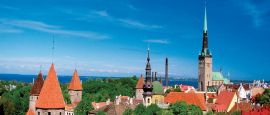Tallinn History
Although there is evidence that the area around Tallinn was first settled around 5000 years ago, the city was never truly noteworthy until a wooden fortress was built upon Toompea hill in 1050. The fortress served as defence against King Valdemar II of Denmark, who led the Northern Crusades to Tallinn in 1219. Despite the best efforts of locals, the city was defeated and Denmark took control.
However, it didn't hold Tallinn for long. By 1285, the city (then known as Reval) had become the most northerly point of the Hanseatic League and was sold off to the Teutonic Knights by the Danes in 1346. The grip of the Teutonic Knights loosened around 1561 and Estonia placed itself under Swedish rule, hoping for protection from Poland and Russia.
When Great Northern War erupted in 1700, the Tsardom of Russia took control of the city and much of the city’s population fled to Finland. Centuries of Russian rule followed, with Tallinn getting its first taste of independence in 1920.
Unfortunately, freedom didn't last long. After World War II, Estonia was ceded to the Soviet Union in 1940. A year later, Nazi Germany came and occupied from 1941 to 1944 during which many Jews died in the Holocaust. After the Nazi left, the Red Army of the Soviet Union arrived, setting the scene for the second period of Russian occupation in Tallinn's history, this time with the city made the capital of the Estonian SSR.
Under Communist rule, culture and the arts were suppressed while ordinary Estonians went about their lives watched closely by the State. There were however lighter moments, with the 1980 Olympics partly staged in the city.
Tallinn’s real renaissance came when Estonia declared independence in 1990, making the city its capital in the process. Today Tallinn has returned to its mercantile roots and is one of the hubs for European trade, as well as a popular tourist destination to boot.
Did you know?
• Tallinn's public transportation system is one of Europe’s oldest and dates back to 1888.
• During the Soviet period, the KGB used the metal spire of St Olav's Cathedral as a radio transmission tower.
• Tallinn claims to have erected the world’s first Christmas tree in 1441.
Do you have any Feedback about this page?
© 2025 Columbus Travel Media Ltd. All rights reserved. No part of this site may be reproduced without our written permission, click here for information on Columbus Content Solutions.




 You know where
You know where